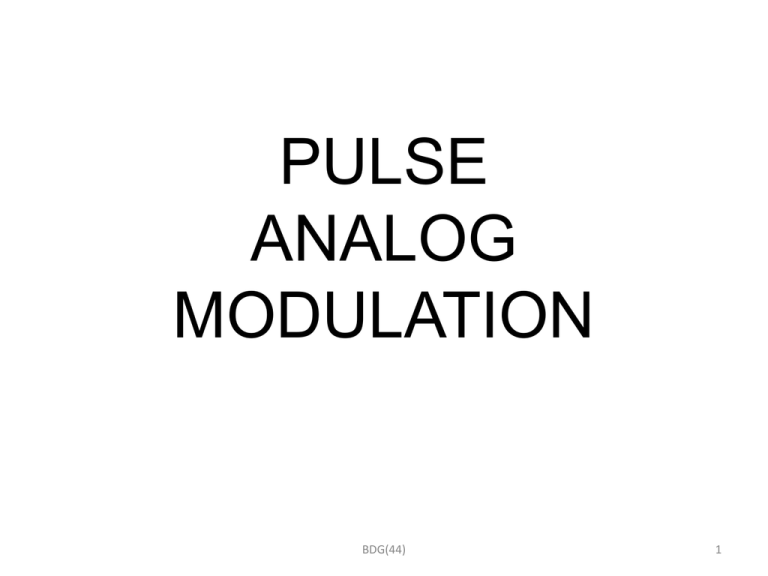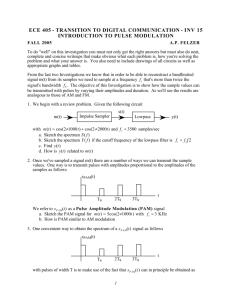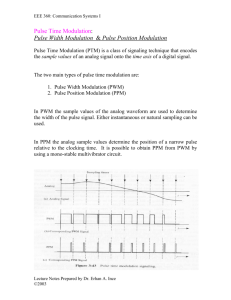PULSE ANALOG MODULATION
advertisement

PULSE ANALOG MODULATION BDG(44) 1 • A Continuous Time (CT) signal can not be processed by the digital processors. • Hence to enable digital transmission of CT, it has to be converted into Discrete Time (DT) signal. ##1 • Sampling Therom gives the criteria for spacing Ts between two consecutive samples. • Sampling is the process of converting a signal (for example, a function of continuous time or space) into a numeric sequence (a function of discrete time or space). BDG(44) 2 • Sampling Theorem for LP signals – • A band limited signal of finite energy, which has no frequency components higher than W Hz, may be completely recovered from the knowledge of its samples taken at the rate of 2W samples per second. • A band limited signal of finite energy, which has no frequency components higher than W Hz, is completely described by specifying the values of the signal at instants of time separated by 1/2W seconds BDG(44) 3 • In short, a CT signal can be completely represented in its samples and recovered back if the sampling frequency (Fs) is twice the highest frequency component of the signal. ( Fs >2W.) • Proof of sampling theorem – • Can be treated as two parts – 1. Representation of x(t) in terms of its samples. 2. Reconstruction of x(t) from its samples. BDG(44) 4 • Part 1- Representation of x(t) in terms of its samples • Step 1- Define xδ(t). • Step 2- FT of xδ(t) i.e. Xδ(f). • Step 3- Relation between X(f) and Xδ(f). • Step 4- Relation between x(t) and x(nTs) • ##2 BDG(44) 5 • Part 2 –Reconstruction of x(t) from its samples• Step 1- Take inverse FT of X(f) which is in terms of Xδt. • Step 2- Show that x(t) is obtained back with the help of interpolation function. • Step 3- Reconstruction of x(t) by low pass filter- When interpolated signal of equation 6 is passed through the low pass filter of BW - W<f <W, the constructed waveform is obtained. BDG(44) 6 • Effect of Under sampling (Aliasing)• Whiling proving sampling theorem it is considered that fs=2W. • Let us consider a case fs<2W. Refer figure. • The spectrum located at X(f),X(f-fs),X(f-2fs) overlaps each other. • The high frequencies near W in X(f-fs) overlap with low frequencies(fs-W)in X(f). BDG(44) 7 • Definition of aliasing – When the high frequency interferes with low frequency and appears as low frequency, then the phenomenon is called aliasing. • Effects of aliasing – (a)Distortion is generated as high and low frequencies interfere with each other. (b) The data is lost and can not be recovered. • Aliasing can be avoided by (a) sampling rate fs more than 2W and (b) strictly bandlimit the signal to W. BDG(44) 8 • (a) Sampling rate fs >= 2W – When the sampling rate is more than 2W, then the spectrum will not overlap and there will be sufficient gap between the individual spectrums. • (b) – Bandlimiting the signal – If the sampling rate fs= 2W, there should not be any aliasing. But there can be few components higher than 2W which may create aliasing. Hence LPF is used before sampling the signal. Output of LPF is bandlimited and there is no frequency component higher than W. Thus avoiding aliasing. ## BDG(44) 9 • Nyquist Rate – • When the sampling rate becomes exactly equal to 2W samples/sec, for a given BW of W hertz, then it is called Nyquist rate. (2W Hz.) • Nyquist Interval – • It is the time interval between any two adjacent samples when sampling rate is Nyquist rate. (1/2W seconds) BDG(44) 10 • Reconstruction Filter ( Interpolation Filter) – • The reconstruction of signal is the succession of sinc pulses weighted by x(nTs). • These pulses are interpolated with the help of LPF. It is called reconstruction or interpolation filter. BDG(44) 11 • Ideal Filter – Refer Figure. • Figure shows the spectrum of the sampled signal and frequency response of the required filter. • When the sampling frequency is exactly 2W, then the spectrum just touches each other. • The spectrum of original signal, X9f) can be filtered by an ideal filter having passband from –W</=f </=W. BDG(44) 12 • Non Ideal filter – • An ideal filter of BW W filters out an original signal. • But practically ideal filter is not realizable. It requires some transition band. • Hence fs must be greater than 2W. It creates the gap between adjacent spectrums of Xδ(f). This gap can be used for the transition band of the reconstruction filter. • The spectrumX9f) is then properly filtered out from Xδ(f). BDG(44) 13 • Sampling of Bandpass Signals – • The bandpass signal x(t) whose maximum BW is 2W can be completely represented into and recovered from its samples if it is sampled at the minimum rate of twice the BW. • Thus if the BW is 2W, then minimum sampling rate for bandpass signal should be 4W samples per second. • Spectrum of BP signal. BDG(44) 14 • The spectrum is centred around frequency fc. The BW is 2W. • The frequencies in the BP signal are from fc –W to fc +W. • The highest frequency present in the BP is fc+W. The centre frequency is greater than W. • In-phase and quadrature components – • xi(t) = In phase component of x(t) • xq(t) = Quadrature component of x(t) • x(t) = xi(t)cos(2*pi*fc*t) - xq(t)sin(2*pi*fc*t) BDG(44) 15 • Generation of in-phase and quadrature components- ## • x(t) is multiplied by cos(2*pi*fc*t) and sin(2*pi*fc*t). The multiplication produces sum and difference frequencies at the out put of the multiplier. • The LPFs suppress the sum frequency and pass only difference frequencies. • Thus xi(t) and xq(t) components contain only low frequency components. • Spectrum ## BDG(44) 16 • Reconstruction of BP signal from In phase and quadrature components - ## • The reconstruction filter generates analog version of in phase and quadrature components. • These xi(t) and xq(t) are multiplied by cos(2*pi*fc*t) and sin(2*pi*fc*t) respectively to shift their frequencies in BP range. • The two products are added to give final BP signal. (##8) BDG(44) 17 • Uniform Sampling Theorem for BP signals -##9 • x(t) can be represented into its samples x(kTs) if sampling rate is fs = 2fxu/m, where m is largest integer not exceeding fxu /Bx. • Examples --- ##10. BDG(44) 18 • Pulse Analog Modulation – • The modulating signal can modulate amplitude, width(duration) or position of the pulse. • Three techniques are • 1. Pulse Amplitude Modulation (PAM) • 2. Pulse Width Modulation (PWM) • 3. Pulse Position Modulation (PPM) BDG(44) 19 • Pulse Amplitude Modulation (PAM) – • The amplitude of the pulse is directly proportional to amplitude of the modulating signal at the sampling instant. The width and position of the pulse remains same. • Generation of PAM – ##9 • The modulating signal x(t). The low pass filter performs Bandlimiting. • The cutoff frequency of LPF is equal to highest fm present in x(t). • Aliasing is avoided by using LPF. BDG(44) 20 • PAM Waveform – BDG(44) 21 • The bandlimited signal is sampled at the multiplier. • The multiplier samples x(t) with the help of a pulse train generator. • The pulse train generator produces the pulse train c(t) . • The multiplication of c(t) and x(t) produces y(t), the PAM signal. • The top of the pulses are varied according to amplitude of x(t). BDG(44) 22 • Detection of PAM – • The PAM signal is passed through a LP reconstruction filter which reconstructions the analog signal from PAM pulses. • Transmission BW of PAM Signal – • The pulse duration τ(tau) is very very small as compared to time period Ts between two samples. If max. frequency is W, then according to sampling theorem fs should be more than Nyquist rate i.e. fs>/= 2W. • Or Ts</= 1/2W & τ(tau) <<Ts </= 1/2W. BDG(44) 23 • If On and OFF time of the pulse is same, then frequency of PAM pulses becomes f = 1/2 τ(tau) = f max. • BW required for transmission of PAM signal will be equal to maximum frequency fmax given by above equation. • This BW gives adequate pulse resolution, Bt >/= f max or Bt >/= 1/τ(tau). • Since τ(tau) << 1/2W, Bt >/= 1/2τ(tau) >>W. • Transmission BW of PM signal Bt >> W. • Thus the BW of PAM is very very large as compared to highest frequency in the signal x(t). BDG(44) 24 • Advantages of PAM – • 1. PAM forms the basis for other pulse modulation techniques (PCM,ADM,DM etc.). • 2. PAM can be easily generated and detected. BDG(44) 25 • Disadvantages of PAM – • 1. The amplitude of PAM pulses varies as per modulating signal. Hence interference of noise is maximum for PAM and this noise can not be eliminated easily. • 2. As amplitude of PAM signal varies, it also varies the peak power required by the transmitter with modulating signal. • 3. The BW needed for transmission of PAM is very large compared to its maximum frequency content. BDG(44) 26 • Application – • 1. It is used in A to D converters for computer interfacing. • 2. PAM is used in instrumentation system. • 3. PAM is used for transmitting signals over a short distance BB channels. BDG(44) 27 • Pulse Width Modulation – ( also known as Pulse Time Modulation) • Two Types – 1. PWM or Pulse Duration Modulation. 2. Pulse Position Modulation. • Principle of PWM (PDM) • The width of the pulse is directly proportional to amplitude of the modulating signal at the sampling instant. • The amplitude and position of the pulse remains unchanged. BDG(44) 28 • PWM Generation - ##10. • A monostable multivibrator with modulating in put applied at the control voltage input. • Internally the control voltage is adjusted to 2/3 Vcc. • Externally applied modulating signal changes the control voltage and hence the threshold voltage level, giving PWM signal at the output. (diagram). BDG(44) 29 BDG(44) 30 • Demodulation of PWM signal - ##11 • The received PWM signal is applied to the Schmitt trigger circuit, which removes the noise in the PWM waveform. • The regenerated PWM is then applied to the ramp generator and the synchronization pulse generator. • The ramp generator produces ramps for duration of pulses such that height of the ramps are proportional to the widths of PWM pulses. The maximum ramp voltage is retained till the next pulse. BDG(44) 31 • On the other hand, synchronous pulse generator produces reference pulses with constant amplitude and pulse width. These pulses are delayed by specific amount of delay. • The delayed reference pulses and the output of the ramp generator is added in the adder. The output of the adder is given to the level shifter. • The negative offset waveform is clipped by rectifier and the output is passed through LPF to recover the modulating signal. BDG(44) 32 • Advantages of PWM – • 1. Does not require synchronization between transmitter and receiver. • 2. Separation of signal and noise is easy. • 3. Unlike PAM, noise is less and hence amplitude is held constant in PWM • Disadvantages of PWM – • 1. Large BW is required for PWM as compared to PAM. • 2. Pulses are varying in width and therefore their power contents are variable. So transmitter must handle the power contents of the pulse having maximum PW. BDG(44) 33 • Applications – • 1. PWM is used to generate PPM. • 2. PWM is used for synchronous transmission over noisy channel. • 3. Motor Control. BDG(44) 34 • Pulse Position Modulation – (PPM) • The amplitude and width of the pulses are kept constant, while the position of each pulse with reference to the position of a reference pulse, is changed according to the instantaneous sampled value of the modulating signal. BDG(44) 35 • Generation of PPM – • The sawtooth generator generates the sawtooth signal of frequency fs (period 1/Ts). • The saw tooth signal, also called sampling signal is applied to the inverting input of comparator. • The modulating signal x(t) is applied to the non inverting input of the comparator. • The out put of the comparator is high only when instantaneous value of x(t) is higher than that of sawtooth waveform. BDG(44) 36 • Thus the leading edge of the PDM signal occurs at the fixed time period (kTs)the trailing edge of the output of comparator depends on the amplitude of signal x(t). • When sawtooth waveform voltage is greater than voltage of x(t) at that instant, the output of comparator remains zero. • The trailing edge of the output of the comparator (PWM) is modulated by signal x(t). BDG(44) 37 • If the sawtooth wave form is reversed, then the trailing edge will be fixed and leading edge will be modulated. • If sawtooth waveform is replaced by triangular waveform, then both leading and trailing edges will be modulated. • The PWM (PDM) signal is nothing but output of the comparator. The output of this PWM(PDM) will be positive saturation of the comparator. (as shown as A in fig.) • The amplitude is same for all pulses. BDG(44) 38 • To generate PPM, PWM (PDM) signal is used as the trigger input to monostable multivibrator. • The output of mono remains zero until it is triggered. • The mono is triggered on the trailing(falling) edge of PWM. • The output of mono then switches to positive saturation level. BDG(44) 39 • This voltage remains high for the fixed period and then goes low. • The mono determines the width of the pulse. • The pulse is thus delayed from sampling time kTs depending on the amplitude of signal x(t) at kTs. BDG(44) 40 • Demodulation of PPM signal – • In the case of PPM, it is customary to convert the received pulses that vary in position to pulses that vary in length. (fig). • The flip flop circuit is set or turned ‘ON’ (giving high output) when reference pulse (generated by reference pulse generator of the receiver with the synchronization signal from the transmitter) arrives. • The flip flop is reset or turned ‘OFF’ (giving low output) at the leading edge of the position modulated pulse. BDG(44) 41 • This repeats and we get PWM pulses at the output of F-F. • The PWM pulses are then demodulated by PWM demodulator to get original message signal. • Application – Synchronous communication of analog pulses over short distances. BDG(44) 42 • Advantages – 1. Due to constant pulse widths and amplitude, transmission power of each pulse is same. 2. Like PWM, in PPM amplitude is held constant resulting less noise interference. 3. Like PWM, signal and noise separation is easy. • Disadvantages – 1. Synchronization between transmitter and receiver is required. 2. Large BW is required as compared to PAM. BDG(44) 43 • Comparison of Various Pulse Modulation Methods – Sr No. PAM PWM/PDM PPM 1 Amplitude of pulse is proportional to amplitude of Modulating signal. 2 BW of channel depends on BW of channel depends width of the pulse. on rise time of the pulse. BW of channel depends on rise time of the pulse. 3 The instantaneous power of the transmitter varies. The instantaneous power of the transmitter varies. The instantaneous power of the transmitter remains constant. 4 Noise interference is high. Noise interference is high. Noise interference is high. 5 System is complex. System is simple. System is simple. 6 Similar to AM. Similar to FM. Similar to PM. Width of pulse is Relative position of pulse proportional to amplitude is proportional to of Modulating signal. amplitude of Modulating signal. BDG(44) 44





